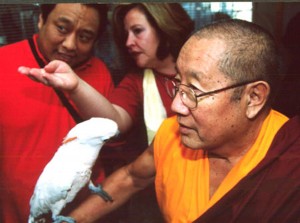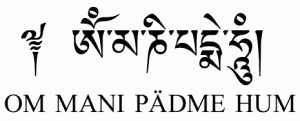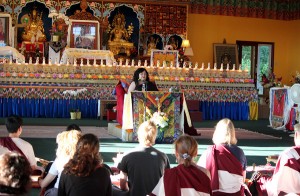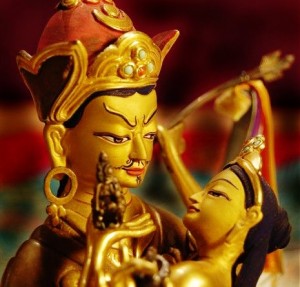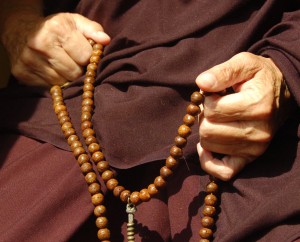The following is an excerpt from a teaching by Jetsunma Ahkon Lhamo offered at Palyul Ling Retreat 2012:
His Holiness Penor Rinpoche was one of the most stubborn lamas in the beginning. He did not want to teach Dzogchen yet, because he didn’t want to throw Dharma on the floor. Instead he wanted everybody to learn the great bodhicitta, and he made you understand that there is no power anywhere stronger than the bodhicitta.
When Tibetan kids are young, their moms or their Amas, their nannies, or whoever takes care of them, teaches them about kindness. It’s customary. It’s what happens. That doesn’t happen here in America. It’s so fortunate that Tibetan Amas and mommies teach their children that way from birth.
I think in some ways we should think of our own mothers who have taught us like that to be like a root guru to us. The first one that taught you to be kind, that’s a root guru. The first one that taught you to love, that’s a root guru. The first one that taught you that bodhicitta is the most important power in the universe, that’s a root guru. His Holiness taught me that, and he is my root guru.
I wish the fashion would turn around, and that there would be more teachings given out constantly about bodhicitta. I wish we would not set it aside. I wish Tibetan lamas would not listen to us, because we are so prideful and so willing to think that we know what’s best. His Holiness was one of the last ones that gave in and began to teach some Dzogchen. I think he felt the way I do—that bodhicitta is the most important thing. Once when he saw the dogs and the parrots that we were saving, he said, “That’s Dharma. That’s Dharma.” That’s what His Holiness said, and I believe it. I know it to be true. Kindness is the way.
. . . Sometimes we can be so prideful. We think that having practiced so well it is not necessary for us to be kind. We can concentrate on the academic part, the intellectual part, and then we will have it all down perfectly. But that is not really the truth. Academics is part of the teaching. Meditation is part of the teaching. Taking vows, that’s part of it. Please don’t forget, most important is the great bodhicitta. It is the very display of all that is light and pure. It is the very display of goodness. We like to forget it and let it go, but please don’t. I beg of you. Don’t do that.
Your mind will stay fresh and sweet if you are always concerned for sentient beings. And we must always be concerned for sentient beings because they don’t know how to take care of themselves. They don’t know how to do what is necessary to accomplish any Dharma or anything really meaningful in their lives. Many people get a scholarship and they go to college and then that’s it. They’ve done it. But it’s not true. It is most important to develop kindness. It is most important to be kind.
For those of you who are unforgiving in your demeanor and not so kind, you don’t give Buddhism a good image. That should be what it is all about to you. I will assume that probably isn’t pleasant to hear, but it is what I believe and what I know. If you did nothing else but take the bodhisattva vow and spend the rest of your life praying and benefitting sentient beings, you will have accomplished a lot. When you go back home, whether it is New York City or Kalamazoo or wherever it is, bring this little bit of information with you.
. Look around. Stop closing your eyes. Are you going out to dinner this evening? Then notice the person sitting on the street with nothing to eat. Maybe bring them what’s left or give them some money for some food. If you are going to the movies, think about it twice. Go to the movie but then take the same amount of money and give it to someone who really needs it. I believe in that. It is called paying it forward. And it is the best display that you can possibly give people about what the Dharma is. If you display your activity like that, they will understand. They will understand what Dharma is. But if we are self-important, prideful and in love with ourselves, we will never see the beauty of Dharma. Never. We must see this. We must understand that Dharma is not different from loving-kindness, and it is not different from our nature.
Copyright © Jetsunma Ahkon Norbu Lhamo All rights reserved
